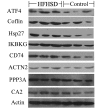Global Transcriptomic Profiling of Cardiac Hypertrophy and Fatty Heart Induced by Long-Term High-Energy Diet in Bama Miniature Pigs
- PMID: 26161779
- PMCID: PMC4498776
- DOI: 10.1371/journal.pone.0132420
Global Transcriptomic Profiling of Cardiac Hypertrophy and Fatty Heart Induced by Long-Term High-Energy Diet in Bama Miniature Pigs
Abstract
A long-term high-energy diet affects human health and leads to obesity and metabolic syndrome in addition to cardiac steatosis and hypertrophy. Ectopic fat accumulation in the heart has been demonstrated to be a risk factor for heart disorders, but the molecular mechanism of heart disease remains largely unknown. Bama miniature pigs were fed a high-fat, high-sucrose diet (HFHSD) for 23 months. These pigs developed symptoms of metabolic syndrome and showed cardiac steatosis and hypertrophy with a greatly increased body weight (2.73-fold, P<0.01), insulin level (4.60-fold, P<0.01), heart weight (1.82-fold, P<0.05) and heart volume (1.60-fold, P<0.05) compared with the control pigs. To understand the molecular mechanisms of cardiac steatosis and hypertrophy, nine pig heart cRNA samples were hybridized to porcine GeneChips. Microarray analyses revealed that 1,022 genes were significantly differentially expressed (P<0.05, ≥1.5-fold change), including 591 up-regulated and 431 down-regulated genes in the HFHSD group relative to the control group. KEGG analysis indicated that the observed heart disorder involved the signal transduction-related MAPK, cytokine, and PPAR signaling pathways, energy metabolism-related fatty acid and oxidative phosphorylation signaling pathways, heart function signaling-related focal adhesion, axon guidance, hypertrophic cardiomyopathy and actin cytoskeleton signaling pathways, inflammation and apoptosis pathways, and others. Quantitative RT-PCR assays identified several important differentially expressed heart-related genes, including STAT3, ACSL4, ATF4, FADD, PPP3CA, CD74, SLA-8, VCL, ACTN2 and FGFR1, which may be targets of further research. This study shows that a long-term, high-energy diet induces obesity, cardiac steatosis, and hypertrophy and provides insights into the molecular mechanisms of hypertrophy and fatty heart to facilitate further research.
Conflict of interest statement
Figures








Similar articles
-
A Long-Term High-Fat/High-Sucrose Diet Promotes Kidney Lipid Deposition and Causes Apoptosis and Glomerular Hypertrophy in Bama Minipigs.PLoS One. 2015 Nov 16;10(11):e0142884. doi: 10.1371/journal.pone.0142884. eCollection 2015. PLoS One. 2015. PMID: 26571016 Free PMC article.
-
Transcriptome analysis on the inflammatory cell infiltration of nonalcoholic steatohepatitis in bama minipigs induced by a long-term high-fat, high-sucrose diet.PLoS One. 2014 Nov 21;9(11):e113724. doi: 10.1371/journal.pone.0113724. eCollection 2014. PLoS One. 2014. PMID: 25415189 Free PMC article.
-
MicroRNA Expression Signature Is Altered in the Cardiac Remodeling Induced by High Fat Diets.J Cell Physiol. 2016 Aug;231(8):1771-83. doi: 10.1002/jcp.25280. Epub 2015 Dec 30. J Cell Physiol. 2016. PMID: 26638879
-
Multifarious molecular signaling cascades of cardiac hypertrophy: can the muddy waters be cleared?Pharmacol Res. 2010 Nov;62(5):365-83. doi: 10.1016/j.phrs.2010.07.003. Epub 2010 Jul 17. Pharmacol Res. 2010. PMID: 20643208 Review.
-
Combined Pharmacological Modulation of Translational and Transcriptional Activity Signaling Pathways as a Promising Therapeutic Approach in Children with Myocardial Changes.Biomolecules. 2024 Apr 13;14(4):477. doi: 10.3390/biom14040477. Biomolecules. 2024. PMID: 38672493 Free PMC article. Review.
Cited by
-
Transcriptome Analysis Reveals the Effect of Long Intergenic Noncoding RNAs on Pig Muscle Growth and Fat Deposition.Biomed Res Int. 2019 Jun 25;2019:2951427. doi: 10.1155/2019/2951427. eCollection 2019. Biomed Res Int. 2019. PMID: 31341893 Free PMC article.
-
High fat diet-induced obesity increases myocardial injury and alters cardiac STAT3 signaling in mice after polymicrobial sepsis.Biochim Biophys Acta Mol Basis Dis. 2017 Oct;1863(10 Pt B):2654-2660. doi: 10.1016/j.bbadis.2017.06.008. Epub 2017 Jun 15. Biochim Biophys Acta Mol Basis Dis. 2017. PMID: 28625915 Free PMC article.
-
Alterations in Blood and Hippocampal mRNA and miRNA Expression, Along with Fat Deposition in Female B6C3F1 Mice Continuously Exposed to Prenatal Low-Dose-Rate Radiation and Their Comparison with Male Mice.Cells. 2025 Jan 23;14(3):173. doi: 10.3390/cells14030173. Cells. 2025. PMID: 39936965 Free PMC article.
-
Identification of MiR-211-5p as a tumor suppressor by targeting ACSL4 in Hepatocellular Carcinoma.J Transl Med. 2020 Aug 28;18(1):326. doi: 10.1186/s12967-020-02494-7. J Transl Med. 2020. PMID: 32859232 Free PMC article.
-
A Long-Term High-Fat/High-Sucrose Diet Promotes Kidney Lipid Deposition and Causes Apoptosis and Glomerular Hypertrophy in Bama Minipigs.PLoS One. 2015 Nov 16;10(11):e0142884. doi: 10.1371/journal.pone.0142884. eCollection 2015. PLoS One. 2015. PMID: 26571016 Free PMC article.
References
-
- Shimabukuro M (2009) Cardiac adiposity and global cardiometabolic risk: new concept and clinical implication. Circ J 73: 27–34. - PubMed
Publication types
MeSH terms
LinkOut - more resources
Full Text Sources
Other Literature Sources
Molecular Biology Databases
Miscellaneous

